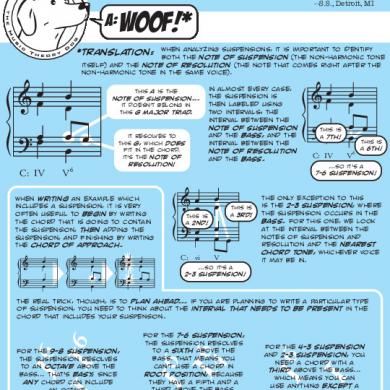Woof!*: Doing Stuff The Sparky Way Is Always Fun!
This document was uploaded by user and they confirmed that they have the permission to share it. If you are author or own the copyright of this book, please report to us by using this DMCA report form. Report DMCA
Overview
Download & View Woof!*: Doing Stuff The Sparky Way Is Always Fun! as PDF for free.
More details
- Words: 375
- Pages: 1
Loading documents preview...
Hey, it’s kids!
music theory for musicians and normal people by toby w. rush
Sparky the music theory dog! Dear Sparky:
understand pitch class sets, normal form and prime form, but are there other Q: Iways to describe a chord using set theory?
-G.L., Corona del Mar, CA
A: WOOF!*
because set theory is primarily interested in the intervals which make up a chord, prime form is usually the best way to categorize chords using set theory... but there are other ways theorists use to describe sets in their prime form!
*translation:
howard hanson, one of the first proponents of set theory, came up with a code which counted each type of basic P4 M3 m3 interval, ordered from P5 m6 M6 consonance to dissonance:
to figure out the hanson analysis, list the letters in this order, omitting any intervals not present and using superscripted numbers to show duplicates.
M2 m2 TT m7 M7
P M N S D T
hanson analysis:
hanso n
[0,3,4,7] = PM2N2D [0,1,2,6] = PMSD2T
bœœœ b &
PDT
forte
twentiethcentury theorist Allen Forte figured that since there was a finite number of possible sets, someone ought to catalog them all!
of course, that someone was Allen Forte, who came up with the system of forte numbers: a unique number for each and every possible set. how do you figure out a set’s forte number? step one: look it up on the chart.
[0,1,6]
you could use a mnemonic to remember the order... like “please make nick stop doing that”!
nowadays, most theorists express this concept in a more mathematical way, using what we call an interval vector:
m2 M2 m3 M3 P4 TT M7 m7 M6 m6 P5
( # # forte number:
deyoe
wait... doing what?
# #
#
# )
[0,3,4,7] = (102210) [0,1,2,6] = (210111)
in his chart, forte labeled sets which had different prime interval vector: forms but the same interval vector with a (100011) “z”. like 4z-15 and 4z-29, which are both called there is all-interval no step tetrachords... two! since they both have the interval vector (1,1,1,1,1,1)!
3-5 Fo t e numr bers
DOING STUFF THE SPARKY WAY IS ALWAYS FUN! licensed under a creative commons BY-NC-ND license - visit tobyrush.com for more
music theory for musicians and normal people by toby w. rush
Sparky the music theory dog! Dear Sparky:
understand pitch class sets, normal form and prime form, but are there other Q: Iways to describe a chord using set theory?
-G.L., Corona del Mar, CA
A: WOOF!*
because set theory is primarily interested in the intervals which make up a chord, prime form is usually the best way to categorize chords using set theory... but there are other ways theorists use to describe sets in their prime form!
*translation:
howard hanson, one of the first proponents of set theory, came up with a code which counted each type of basic P4 M3 m3 interval, ordered from P5 m6 M6 consonance to dissonance:
to figure out the hanson analysis, list the letters in this order, omitting any intervals not present and using superscripted numbers to show duplicates.
M2 m2 TT m7 M7
P M N S D T
hanson analysis:
hanso n
[0,3,4,7] = PM2N2D [0,1,2,6] = PMSD2T
bœœœ b &
PDT
forte
twentiethcentury theorist Allen Forte figured that since there was a finite number of possible sets, someone ought to catalog them all!
of course, that someone was Allen Forte, who came up with the system of forte numbers: a unique number for each and every possible set. how do you figure out a set’s forte number? step one: look it up on the chart.
[0,1,6]
you could use a mnemonic to remember the order... like “please make nick stop doing that”!
nowadays, most theorists express this concept in a more mathematical way, using what we call an interval vector:
m2 M2 m3 M3 P4 TT M7 m7 M6 m6 P5
( # # forte number:
deyoe
wait... doing what?
# #
#
# )
[0,3,4,7] = (102210) [0,1,2,6] = (210111)
in his chart, forte labeled sets which had different prime interval vector: forms but the same interval vector with a (100011) “z”. like 4z-15 and 4z-29, which are both called there is all-interval no step tetrachords... two! since they both have the interval vector (1,1,1,1,1,1)!
3-5 Fo t e numr bers
DOING STUFF THE SPARKY WAY IS ALWAYS FUN! licensed under a creative commons BY-NC-ND license - visit tobyrush.com for more
Related Documents

Woof!*: Doing Stuff The Sparky Way Is Always Fun!
January 2021 1
It Is The Way It Is
March 2021 0
Learn German The Fast And Fun Way
January 2021 0
Flirting Is Fun!
January 2021 1
Always Leading The Pack Always Leading The Pack
January 2021 0
The Benefits Of Doing Sport
February 2021 0More Documents from ""

Woof!*: Doing Stuff The Sparky Way Is Always Fun!
January 2021 1



